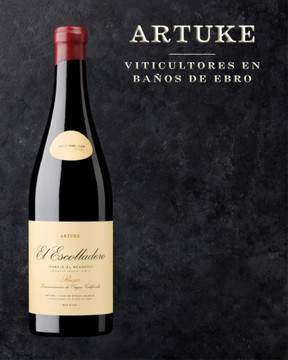
Bodegas Artuke Paso Las Manas 2020.
The 2020s feel very elegant, and the 2020 Paso Las Mañas, which mentions the Paraje El Chorro in Samaniego where the vines are, is no exception. It has a very lively palate that is effervescent with freshness and chalky minerality, leaving a dry sensation that is very tasty, almost salty.
It's young-ish Tempranillo that achieved 13.5% alcohol and kept a pH of 3.42, meaning moderate ripeness, a medium body and very good freshness—a constant across the 2020s. 6,000 bottles were filled in January 2022 after 12 months in 3,500-liter foudre.
Artuke has seen one of the best progressions in Rioja in the last few years and is one of the finest young family wineries in the region. They have 30 hectares planted between 1920 and 2013 in their village, Baños De Ebro and Ábalos, San Vicente de La Sonsierra, Samaniego and Villabuena de Álava and currently produce some 170,000 bottles.
I tasted mainly the 2020s (except the young 2021), a vintage marked by abundant rains during the months of June and July that caused crop losses due to mildew. The rest of the summer saw warm temperatures, and the harvest began in the second week of September, since the decrease in quantity meant that the harvest was a little earlier than the previous year.
The 2020s feel very elegant, and the 2020 Paso Las Mañas, which mentions the Paraje El Chorro in Samaniego where the vines are, is no exception. It has a very lively palate that is effervescent with freshness and chalky minerality, leaving a dry sensation that is very tasty, almost salty.
It's young-ish Tempranillo that achieved 13.5% alcohol and kept a pH of 3.42, meaning moderate ripeness, a medium body and very good freshness—a constant across the 2020s. 6,000 bottles were filled in January 2022 after 12 months in 3,500-liter foudre.
Artuke has seen one of the best progressions in Rioja in the last few years and is one of the finest young family wineries in the region. They have 30 hectares planted between 1920 and 2013 in their village, Baños De Ebro and Ábalos, San Vicente de La Sonsierra, Samaniego and Villabuena de Álava and currently produce some 170,000 bottles.
I tasted mainly the 2020s (except the young 2021), a vintage marked by abundant rains during the months of June and July that caused crop losses due to mildew. The rest of the summer saw warm temperatures, and the harvest began in the second week of September, since the decrease in quantity meant that the harvest was a little earlier than the previous year.







